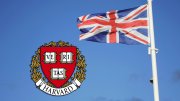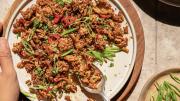The Rarest of the Rare: Stories behind the Treasures at the Harvard Museum of Natural History (HarperResource, $22.95) is a delightful armchair tour through the packed museum with an agreeable guide, staff writer Nancy Pick, who points out scores of interesting specimens and tells how they came to be under Harvard's roof. See George Washington's pheasants, a mastodon skeleton associated with the notorious Webster-Parkman murder case, a painting that catches Audubon in a lie, a sand dollar scooped up by Darwin when he was voyaging on the Beagle, newly discovered fishes, a plant that might fight AIDS, and, of course, a glass flower (a glass diseased apple, to be precise). Mark Sloan contributes 95 color photographs. Pellegrino University Professor emeritus E.O. Wilson, Ph.D. '55, Jf '56, S.D. '04, provides an introduction. The frog and the gold "horn," shown here with captions only, have longer tales to tell in the book. Pick's account of a pet parakeet appears in its entirety as an exemplar.
|
Alexander Wilson may lack the name recognition of John James Audubon, but bird experts everywhere know Wilson as "the father of American ornithology." Born in Scotland, Wilson began his career as a weaver and poet, then emigrated in 1794 to the United States. He settled in Philadelphia, and there he wrote his monumental nine-volume American Ornithology, the first comprehensive study of North American birds.
In producing his books, Wilson acted as researcher, writer, and illustrator. He traveled thousands of miles, often on foot, collecting specimens and observing birds in the field. Pictured here is his lovely hand-colored plate of the Carolina parakeet, from volume 3 of his opus, published in 1811. With it is the very specimen that Wilson used as a model for his illustration.
Wilson had a particular fondness for Carolina parakeets. In American Ornithology, he described seeing a great flock of them at Big Bone Lick in northern Kentucky:
They came screaming through the woods in the morning, about an hour after sunrise, to drink the salt water, of which they, as well as the Pigeons, are remarkably fond. When they alighted on the ground, it appeared at a distance as if covered with a carpet of the richest green, orange, and yellow...
Wilson even kept one Carolina parakeet though not the individual shown here as a pet. The bird, which he had slightly wounded in the wing, became his "sole companion in many a lonesome day's march." While traveling on horseback, Wilson bound the parakeet in a silk handkerchief and secured it in his pocket, liberating it at mealtimes and in the evening. "When at night I encamped in the woods," he wrote, "I placed it on the baggage beside me, where it usually sat, with great composure, dozing and gazing at the fire till morning."
Wilson would have been saddened to learn that the Carolina parakeet has become extinct. The last one died in its cage at the Cincinnati Zoo in 1918. The flocks that once ranged over much of the eastern United States disappeared as forests gave way to cropland. Farmers shot the birds to protect their orchards, hunters shot them for sport, and their feathers were used in hats. They were the only parrot native to eastern North America.
|









